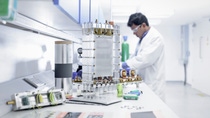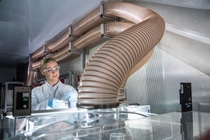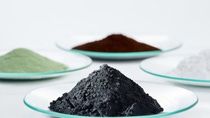Media
How BASF is contributing to a more sustainable reality

At BASF we innovate and we create chemistry for a more sustainable future.
Climate change is among the greatest challenge of our lifetime. Temperatures have consistently risen, oceans are getting warmer, glaciers are retreating, ice sheets melting, and natural disasters have become more frequent. Innovation, technology, and collaboration are key to driving sustainable solutions that can help address the realities of climate change, and companies like BASF are playing an essential part in these efforts.
Sustainability is a fundamental element of BASF’s organizational DNA and the core of its corporate purpose: We create chemistry for a sustainable future. Recently, BASF has raised the stakes and set ambitious climate protection targets: to achieve net zero CO2 emissions1 by 2050, and a 25% decrease in emissions by 2030 compared with 2018 – while continuing to grow production volumes. This represents a decrease of around 60% compared with 1990.
But what is BASF doing today to contribute to a more sustainable reality in the U.S. and around the world? Learn more about some of the key initiatives below:
Implementing a circular economy is an essential area of focus for BASF. It doesn’t just help expand the company’s portfolio while lowering its carbon footprint, but it also helps clients reduce their carbon footprint and the carbon footprint of their products.
Unlike the linear economy, which essentially promotes a take-make-dispose scheme, the circular economy provides an eco-effective way of reusing or recycling resources and disposing of waste without losing the added value of materials.
Incorporating sustainable sourcing of alternative raw materials is a big part of this effort. These raw materials may be bio-based, such as bio-based naphtha and biogas, but they can also be obtained through credible sustainable processes and supply chains, such as RSPO-certified palm oil.
Another crucial part of BASF’s circular economy program involves obtaining raw materials from waste-based resources through several different recycling processes. In fact, by 2025, the company aims to process 250,000 metric tons of recycled feedstock globally, and by 2030 the goal is to double circular sales to reach 17 billion euros.
BASF’s leadership in battery recycling, for example, involves collecting, dismantling, and shredding batteries of electric vehicles (EVs) that have reached their end of life to get black mass, which is a combination of metals such as lithium, nickel, cobalt, and manganese.
Learn more about the life cycle of battery materials
The black mass is later refined to retrieve these metals and produce new lithium-ion batteries. To improve this refining process and obtain even more metals from black mass, BASF recently announced plans to start up a commercial-scale battery recycling prototype plant in Schwarzheide, Germany, which is set to begin manufacturing operations by year-end 2022.
Mechanical and chemical recycling: bringing about new life from waste
One of the ways in which BASF obtains waste-based raw materials is through mechanical recycling. The company recycles plastic, lithium-ion batteries for electric vehicles, and metals to manufacture new products. This process involves shredding and melting the recoverable materials and using it as recyclate to make new products.
The Surface Treatment global business unit of BASF's Coatings division, which operates under the Chemetall brand, is currently developing fresh solutions to help manage plastic waste in a more efficient and sustainable way.
For example, one of the technologies that have helped the company identify and sort plastics in real-time with one push of a button is trinamiX's Mobile NIR Spectroscopy Solution, developed by BASF’s very own startup, trinamiX GmbH.
BASF has also developed additive solutions such as IrgaCycle™ that allow recycled plastics to be used in more high-end products and applications, improving durability, reducing waste, and saving money.
Chemical or advanced recycling is another way in which BASF obtains raw materials, which complements mechanical recycling by replacing fossil-based feedstocks with sustainable alternatives, reducing the demand for non-renewable resources.
One example of this effort is the Ultramid Ccycled products, high-quality synthetic materials that are made from plastic waste and can have several different uses.
BASF has also collaborated with Steelcase to build its 100% recyclable flex perch stool out of the Ultramid B3EG6 Ccycled material.
Through a chemical recycling initiative known as ChemCyclingTM, BASF reuses post-consumer plastic waste, such as automotive tires that have reached their end of life which would otherwise be incinerated or end up in a landfill.
The waste is later turned into a secondary raw material, known as pyrolysis oil. This feedstock material can then be used in BASF’S manufacturing plants as a substitute for fossil resources in the production of various commercial products including food packaging and pharma boxes, without affecting the quality of the finished version.
Renewable energy: powering the chemistry of the future
It’s no secret that the chemical industry requires large quantities of energy. However, this does not mean plants cannot obtain their energy from renewable sources. In fact, in 2022, BASF signed several power purchase agreements (PPAs) to feed 20 of its U.S. plants with renewable energy, mainly solar and wind, increasing the share of renewable energy across the country to 25%.
This year, BASF also signed a PPA with X-ELIO to support the Freeport site in Texas, amounting to 48 MW of solar energy, which ensures that the total amount of energy purchased by this location will come entirely (100%) from renewable sources.
One of the most outstanding initiatives from BASF Group this year, and one that might change the face of chemistry for years to come, is the new demonstration plant for heated steam cracker furnaces that will be built at the company’s headquarters in Ludwigshafen, Germany.
Steam cracker furnaces play an essential role in a vast number of production processes in the chemical industry, helping break saturated hydrocarbons like naphtha into smaller ones, like ethylene. However, to do this, they require substantial amounts of energy and release CO2 in the process. The new heated steam cracker furnaces that will be built by BASF, SABIC, and Linde, can reduce CO2 emissions by up to 90%.

Electromobility: the automotive industry goes green
BASF has long been a major supplier to the automotive industry, but today, the company is also a leading supplier of battery materials for electric vehicles.
Additionally, BASF’s Catalysts division provides several different EV-related products including battery components and materials used in charging infrastructures, electric motors, and powertrains, as well as materials for thermal, noise, vibration, and cable management.
The company is also one of the lead suppliers of cathode active materials (CAMs) in the U.S., which are key to reducing the cost of batteries as well as increasing their range and lifetime. One of BASF’s main goals in electromobility is to contribute to a sustainable battery materials value chain, reducing CO2 levels while increasing the use of renewable energy and making processes even more efficient.
BASF also promotes the responsible sourcing of minerals to ensure a sustainable global supply chain of raw materials and engages with initiatives that foster a responsible Artisanal and Small-Scale Mining (ASM) standard. As a member of the “Together for Sustainability” supply chain initiative, the company is audited according to the highest sustainability standards in the world.
Chemistry can be the answer to a more sustainable world
Historically, the chemical industry has always been energy and carbon-intensive, but this doesn't have to be the way forward. Large strides have been made toward developing better, cleaner chemistry and although there is much yet to be done, we are moving in the right direction.
Chemistry can be the answer to finding new and more environmentally friendly alternatives to traditional processes and product developments.
That is what BASF aims to do every day to help address some of society’s most pressing challenges and build a brighter and more viable future for us all. BASF invests in research, innovates, and co-creates with customers and industry partners, all to fulfill its continued promise of "creating chemistry for a sustainable future".
1 The goal includes Scope 1 and Scope 2 emissions without emissions from sale of energy to third parties. Other greenhouse gases are converted into CO2 equivalents according to the Greenhouse Gas Protocol.
Published on November 28, 2022 by Mariana Licio.
For media inquiries or to repurpose this article, please contact Lisa Brown.
